Goaltide Daily Current Affairs 2020
Current Affair 1:
Solar Projects in India.
Recently, the Prime Minister has inaugurated the 750 MW (Mega Watt) solar project set up in Rewa, Madhya Pradesh. Our concern here is something else.
- Details of the Rewa Project.
- Current Solar Status of India
Details about the Project.
- The Rewa Ultra Mega Solar Limited (RUMSL) project is Asia’s largest single-site solar power plant with a total solar installed capacity of 750 megawatts.
- It has three solar generating units of 250 MW each spread over 500-hectare land, in a 1590-hectare solar park.
- The mega solar plant has been designed in a joint venture of Madhya Pradesh Urja Vikas Nigam Limited (MPUVN) and Solar Energy Corporation of India (SECI).
- It will cater to the needs of different type of power off-takers, including Power Management Company, Madhya Pradesh, as well as Delhi Metro Rail Corporation.
- By catering 24 per cent of the energy to Delhi Metro it will become the first renewable energy solar plant to conduct an inter-state sale of solar electricity.
- The Rewa solar plant exemplifies India’s commitment to attain the target of 175 gigawatt (GW) of installed renewable energy capacity by 2022.
Solar Status in India:
Whenever any news comes about solar energy, first and most important thing that should come up in your mind is India’s Intended Nationally Determined
Contribution (INDCs), i.e. To achieve about 40 per cent cumulative electric power installed capacity from non-fossil fuel-based energy and Solar energy is part of non-fossil fuel-based energy.
Keeping this in mind, A target of installing 175 GW of renewable energy capacity by the year 2022 has been set which includes:
100 GW from solar (40GW rooftop solar electricity generation and 60GW large and medium-scale grid-connected solar projects (60 GW), 60 GW from wind, 10 GW from bio-power and 5 GW from small hydropower.
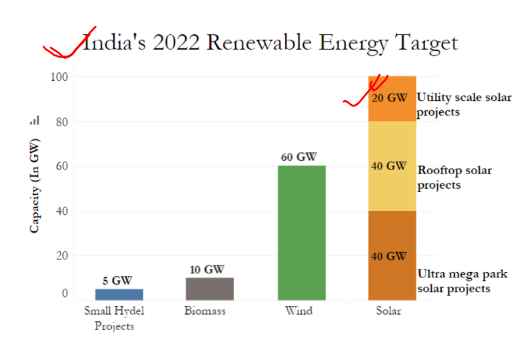
According to 2019 MNRE annual report, A total of around 84.40 GW of renewable energy capacity has been installed in the country Renewable Energy capacity is rising rapidly and the status of projects as on 17.12.19 is given below:
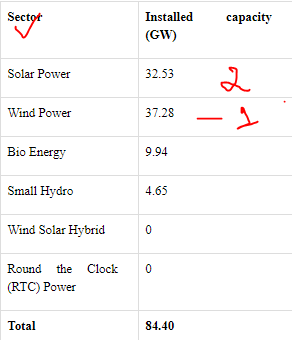

Extra Information:
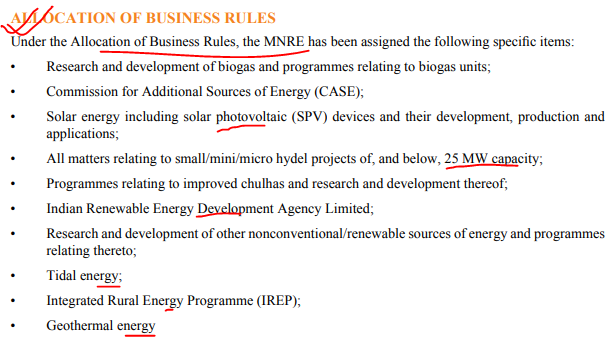
Also see, SARAL – ‘State Rooftop Solar Attractiveness Index
SARAL is the first of its kind index to provide a comprehensive overview of state-level measures adopted to facilitate rooftop solar deployment. SARAL has been designed collaboratively by the Ministry of New and Renewable Energy (MNRE), Shakti Sustainable Energy Foundation (SSEF), Associated Chambers of Commerce and Industry of India (ASSOCHAM) and Ernst & Young (EY). It was launched during the Review Planning and Monitoring (RPM) Meeting with States and State Power Utilities. SARAL currently captures five key aspects –
- robustness of policy framework
- implementation environment
- investment climate
- consumer experience
- business ecosystem
The State of Karnataka has been placed at the first rank in the Index that evaluates Indian states based on their attractiveness for rooftop development.
Current Affair 2:
Mongolian Kanjur Being Reprinted
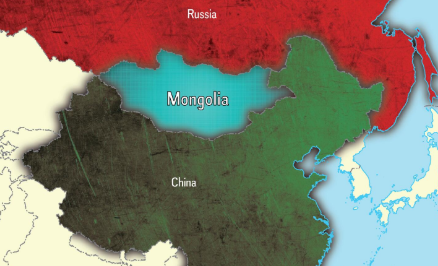
The Ministry of Culture has taken up the project of reprinting 108 volumes of Mongolian Kanjur under the National Mission for Manuscripts (NMM).
Mongolian Kanjur:
- The Buddhist canonical text in 108 volumes is considered to be the most important religious text in Mongolia.
- In the Mongolian language ‘Kanjur’ means ‘Concise Orders’- the words of Lord Buddha in particular.
- It is held in high esteem by the Mongolian Buddhists and they worship the Kanjur at temples and recite the lines of Kanjur in daily life as a sacred ritual.
- The Kanjur are kept in almost every monastery in Mongolia.
- Mongolian Kanjur has been translated from Tibetan. The language of the Kanjur is Classical Mongolian.
- The Mongolian Kanjur is a source of providing a cultural identity to Mongolia.
National Mission for Manuscripts

The National Mission for Manuscripts (NMM) was launched in February 2003 by the Government of India with the mandate of documenting, conserving and disseminating the knowledge preserved in the manuscripts.
A manuscript is a handwritten composition on paper, bark, cloth, metal, palm leaf or any other material dating back at least seventy-five years that has significant scientific, historical or aesthetic value. Lithographs and printed volumes are not manuscripts.
Manuscripts are distinct from historical records such as epigraphs on rocks, revenue records which provide direct information on events or processes in history.
One of the objectives of the mission is to publish rare and unpublished manuscripts so that the knowledge enshrined in them is spread to researchers, scholars and the general public at large. It is under the Ministry of Culture.
Current Affair 3:
Black-Necked Crane
News is:
Birdlife International, the official IUCN Red List authority for birds, has proposed down-listing Black-Necked Crane (BNC) from ‘vulnerable’ to ‘least concern’, and the proposal was uploaded to its website for public comments in June. Easing the Red List status of the BNC without discussing all these aspects could lead us into a false sense of security and increase the birds’ risk of extinction.
So, our concern here is to learn about Blue-Necked Crane (MNC).
Black-necked cranes are iconic birds of the Tibetan Plateau and are of great spiritual and cultural significance to Tibetan Buddhism as well as are integral to the landscape’s biophysical ecosystem.
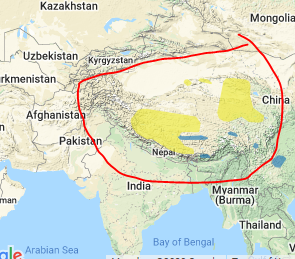
Description:
- These medium-sized alpine cranes, weighing about 5 kg each and standing about 115 cm tall, have a patch of red on their crowns, grey bodies and a characteristic black-neck.
- Meadows are their favoured habitat, where they can feed on roots, insects, snails, fish, frogs, small birds and rodents.
- They breed exclusively in alpine meadows, at altitudes of 2,600 to 4,900 m, and as a protection from predators’ nest in marshes where the water is about 30 cm deep.
- In winter, they migrate to river valleys at lower altitudes, preferably to areas near crop fields.
The Birds are threatened by human- and climate-change-induced habitat loss, and of late also by free-ranging dogs in their breeding areas and food shortage in wintering areas. As a result, they are currently listed as ‘vulnerable’ in the IUCN Red List. 
Also learn BirdLife International
BirdLife International is a global partnership of conservation organizations (NGOs) that strives to conserve birds, their habitats and global biodiversity, working with people towards sustainability in the use of natural resources.
The International Council for Bird Preservation (ICBP) was formed in 1922 becoming the first truly international conservation organisation. In 1992, ICBP becomes BirdLife International and the BirdLife Partnership is born. It started with 20 Partners and now comprises 120 and continues to grow.
Current Affair 4:
Rare Neurological Disorder, Guillain-Barré Syndrome, Linked to COVID-19

What is Guillain-Barré syndrome?
Guillain-Barré syndrome occurs when the body’s own immune system attacks and injures the nerves outside of the spinal cord or brain – the peripheral nervous system. Most commonly, the injury involves the protective sheath, or myelin, that wraps nerves and is essential to nerve function. Without the myelin sheath, signals that go through a nerve are slowed or lost, which causes the nerve to malfunction.
Syndrome relation with COVID-19
As the COVID-19 pandemic sweeps across the globe, many neurologic specialists have been on the lookout for potentially serious nervous system complications such as Guillain-Barré syndrome. Though Guillain-Barre Syndrome is rare, it is well known to emerge following bacterial infections, such as Campylobacter jejuni, a common cause of food poisoning, and a multitude of viral infections including the flu virus, Zika virus and other coronaviruses.
Studies showed an increase in Guillain-Barré syndrome cases following the 2009 H1N1 flu pandemic, suggesting a possible connection. The presumed cause for this link is that the body’s own immune response to fight the infection turns on itself and attacks the peripheral nerves. This is called an “autoimmune” condition. When a pandemic affects as many people as our current COVID-19 crisis, even a rare complication can become a significant public health problem. That is especially true for one that causes neurological dysfunction where the recovery takes a long time and may be incomplete.
While large research studies are underway, overall, it appears that Guillain-Barré syndrome is a rare but serious phenomenon possibly linked to COVID-19. Given that more than 10.7 million cases have been reported for COVID-19, there have been 10 reported cases of COVID-19 patients with Guillain-Barré syndrome so far – only two reported cases in the US, five in Italy, two cases in Iran and one from Wuhan, China.
Current Affair 5:
ICMR Plans National “Sero-Survey” to Determine Population’s Exposure
Just to make you know about the term Sero-Survey. Very small news, this term is important.
The ICMR said a nationwide Sero-Survey to determine the exposure of the novel coronavirus among the population will be carried out as a follow-up to a similar study conducted in May, the results of which are yet to be released.
The Indian Council of Medical Research (ICMR) will conduct a ‘Sero-survey’ which involves testing of blood serum of people to check for the prevalence of antibodies against coronavirus infection.
The Sero-survey conducted in May had two parts – estimating the fraction of the general population that has been infected with SARS-CoV-2 and estimating the number of people who have been infected with coronavirus in containment zones of hotspot cities.
Current Affair 6:
The Lawlessness of Encounter Killings
The Hyderabad ‘encounter’ killing by the police of the four alleged rapists of the veterinary doctor or Vikas Dubey encounter in Uttar Pradesh again raises questions about the validity of the tool of extrajudicial killings devised.
Some judgements and constitutional Provisions regarding encounter. You can quote such judgements and as an aspirant, you should think as per the law, not in biased form. So, we will see few now,
- As per the news article, the truth is that such ‘encounters’ are, in fact, not encounters at all but cold-blooded murders by the police.
- Article 21 of the constitution states: “No person will be deprived of his life or personal liberty except in accordance with the procedure established by law “. This means that before depriving a person of his life, the state is required to put the person on trial in accordance with the provisions of the Criminal Procedure Code (CrPc). In the trial, the accused must be informed of the charges against him and then given an opportunity to defend himself (through counsel) and only then, if found guilty, can he be convicted and executed.
- Fake ‘encounters’, on the other hand, completely sidestep and circumvent legal procedures, as it essentially means bumping someone off without a trial. Hence it is completely unconstitutional.
- In Prakash Kadam vs Ramprasad Vishwanath Gupta, the Supreme Court observed that fake ‘encounters’ by the police are nothing but cold-blooded murders, and those committing them must be given death sentences, placing them in the category of ‘rarest of rare cases. In paragraph 26 of the judgment, it was observed: “Trigger happy policemen who think they can kill people in the name of ‘encounter’ and get away with it should know that the gallows await them”.
- In the Hyderabad incident, it seems evident that the ‘encounter’ was fake. The four accused were in police custody and were unarmed. So how could there have been a genuine encounter? The author concludes by quoting a judgment from Justice A.N. Mulla of the Allahabad high court:
“I say this with all sense of responsibility: there is not a single lawless group in the country whose record of crime comes anywhere near that of the single organised unit called the Indian Police Force. Policemen in general, barring a few, seem to have come to the conclusion that crime cannot be investigated, and security cannot be preserved by following the law, and it can only be achieved by breaking or circumventing the law”.
<< Previous Next >>


